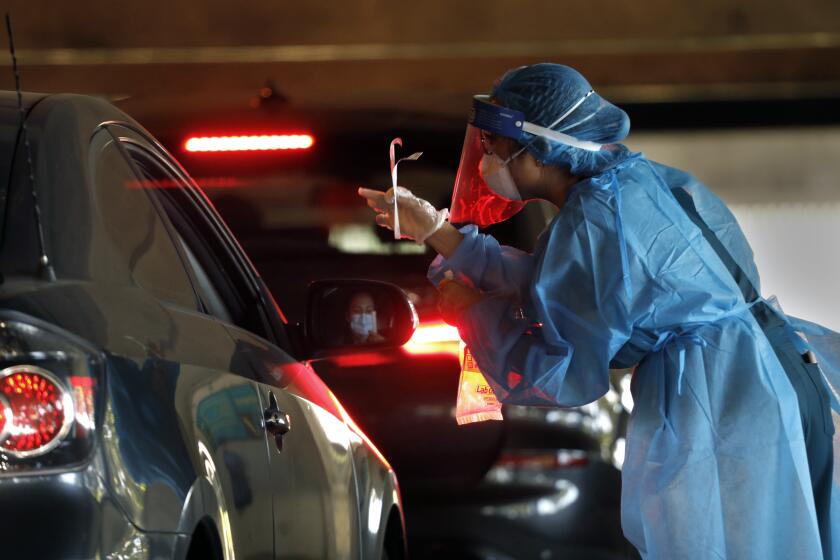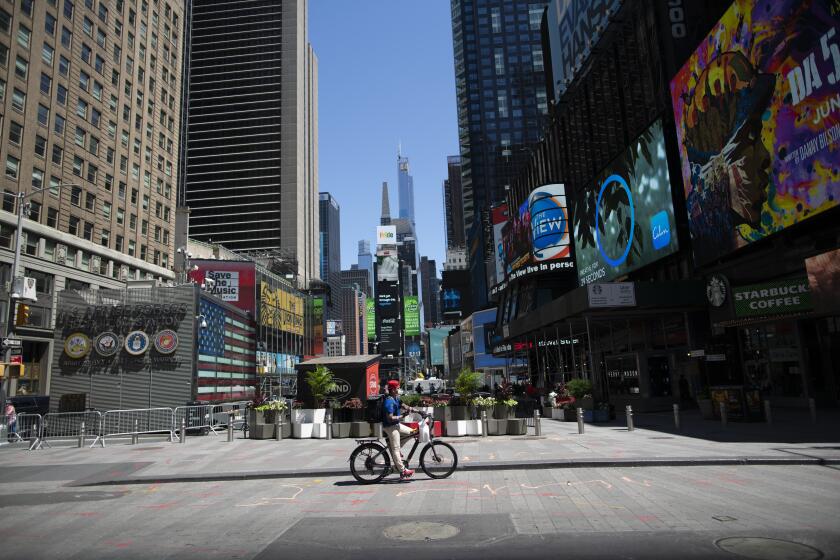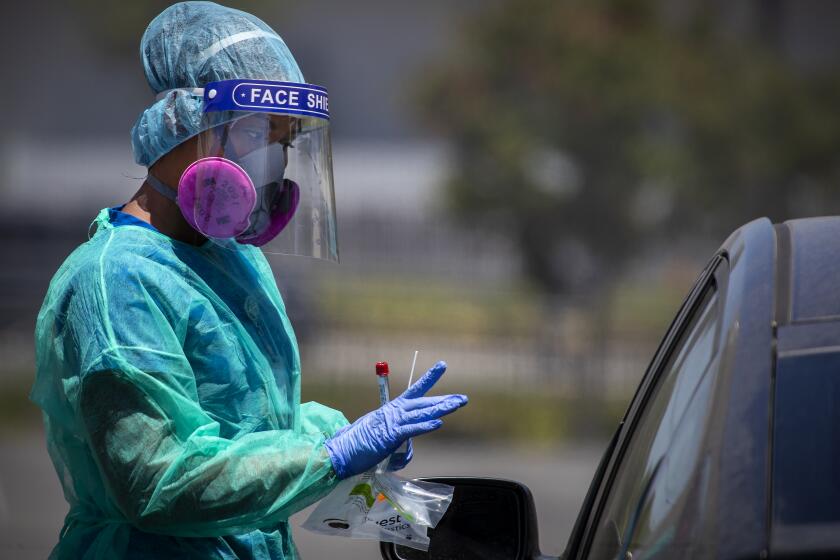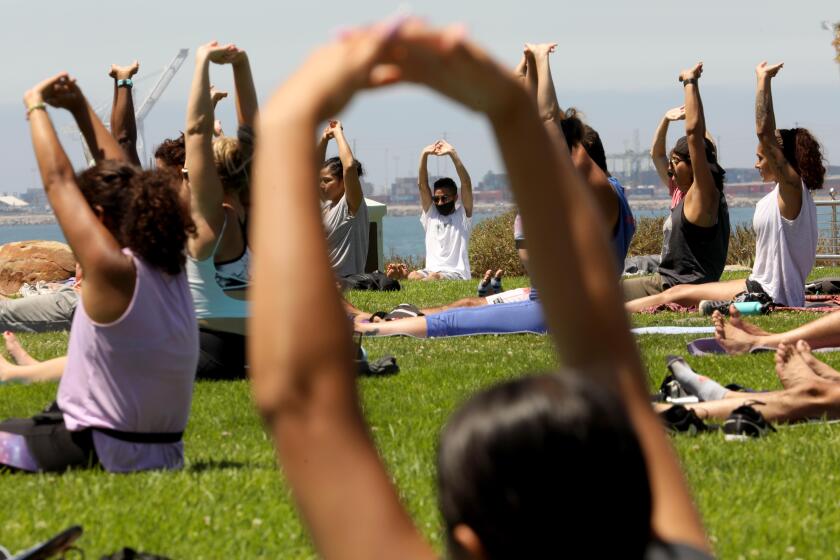California has most COVID-19 cases in U.S., surpassing New York, as spike continues
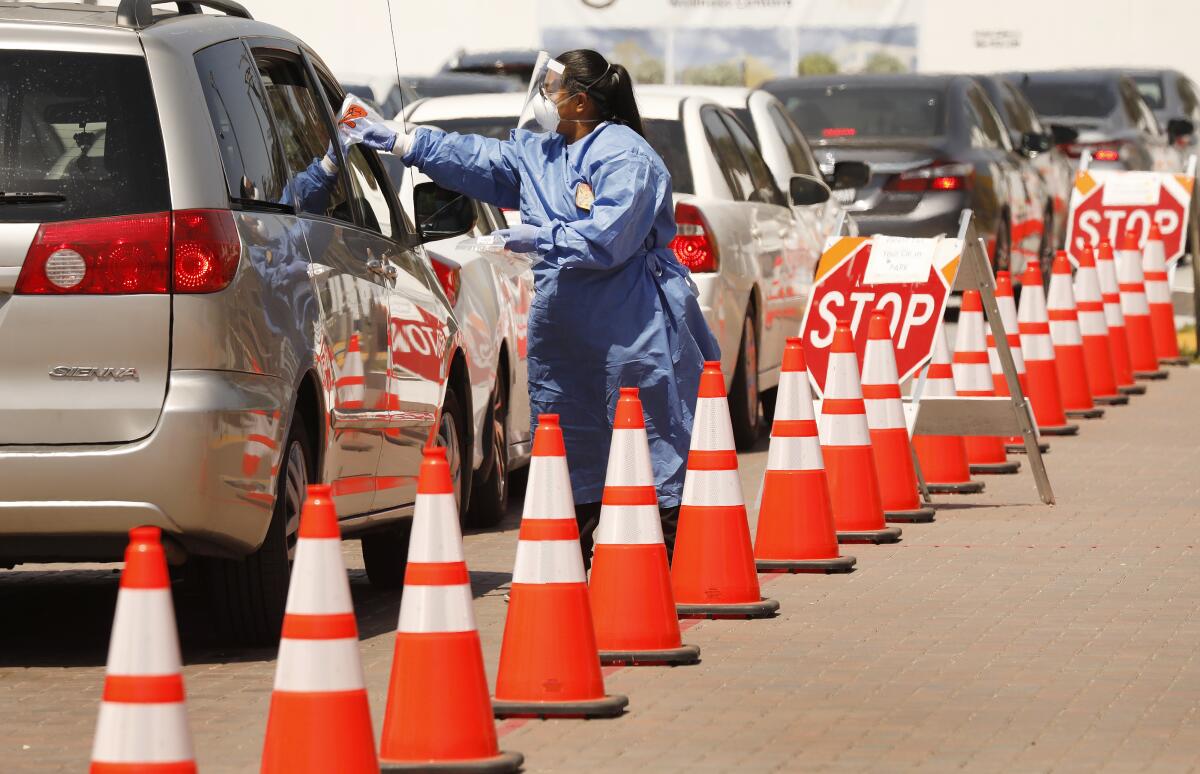
- Share via
California now has the most confirmed coronavirus infections of any state, surpassing New York, as an ongoing statewide spike in the number of infections has pushed its overall case count past 413,000.
As of Wednesday morning, data from Johns Hopkins University showed California had reported about 1,100 more cumulative COVID-19 cases than New York — which was besieged by the virus in the early spring but has since seen the numbers of newly confirmed infections, deaths and hospitalizations drop dramatically.
California, however, is trending in the opposite direction.
Shortly after noon Wednesday, Gov. Gavin Newsom said that 12,807 new coronavirus infections had been reported in the past 24 hours — a record high — bringing the state’s total to 413,576.
“It’s just another reminder … of the magnitude of impact that this virus continues to have,” he said.
On Monday, the state reported 11,554 new coronavirus cases, its highest single-day tally, surpassing a record set a week ago.
Despite the higher case count, California has not experienced nearly as many fatalities as New York has.
The Empire State has recorded more than 25,000 COVID-19 deaths, three times as many as California.
Officials also were quick to point out that California’s population, by far the highest of any state, also plays a major role in its number of infections. The state’s population of nearly 40 million is more than double that of New York.
California’s case rate per 100,000 residents, about 1,046, is significiantly lower than New York’s, which is just under 2,081, according to The Times’ coronavirus tracker.
“I don’t myself over-read into the significance of that number,” California Health and Human Services Secretary Dr. Mark Ghaly said Tuesday when asked about California overtaking New York as the state with the most confirmed cases — pointing to both the state’s population and geographical size.
“I look at every day as an opportunity to do more and do better with our response to COVID-19, and at the end, I really expect and hope that California is going to be the state that adapted the most, learned the most, prepared the best and that we are going to really reduce its impact.”
Newsom agreed that especially given the state’s size, “it’s not surprising now, in some respects, as we’ve begun to reopen key sectors of our economy, people continue to mix and people continue to come in close contact with others that may have contracted this disease, that our numbers would start to go up.”
Nonetheless, he said, California’s case count is “a sober reminder of why we are taking things as seriously as we are.”
Recent data, though, demonstrate how different the situations are in the two states. During the week leading up to and including Tuesday, a total of 4,880 people tested positive for coronavirus infection in New York, numbers from that state’s Department of Health show.
Over that same period, nearly 63,000 people tested positive in California, according to data from The Times’ tracker.
Los Angeles County reported 3,266 new cases on Wednesday alone, pushing its cumulative total above 164,000.
L.A. County Public Health Director Barbara Ferrer also emphasized that there are very real differences between the two states that shape how the pandemic plays out — “We have a lot more people here. We’re also a bigger state and a more geographically diverse state,” she said.
Another key factor, she noted, is that “their reopening is happening later than ours.”
As New York City reopens amid the coronavirus outbreak, some New Yorkers are contemplating whether there is still a place for them.
Ferrer said her team is in regular contact with their New York counterparts to share information, lessons and strategies.
“The issue of trying to make sure that every single person feels like they can remain part of the solution to slowing the spread is something we’re all grappling with,” she said. “We all have seen countless scenes where people are, in fact, not using common-sense precautions and it is resulting in increased spread.”
Despite the increase in cases, L.A. Mayor Eric Garcetti said Wednesday that the virus case positivity rate had declined slightly for the first time in several weeks.
The seven-day average of positive cases is at 10%, compared with 13.6% last week, he said during an evening media briefing. Though the COVID-19 threat level remains at “orange,” or “high risk,” Garcetti said, the city is “not moving to red and we are not closing any additional businesses or activities.”
In San Francisco, Mayor London Breed announced expanded testing for the coronavirus Wednesday as positive cases in the city swelled to nearly 5,000. The city is now testing 3,212 people a day, she said during a virtual news conference, and is adding 1,400 more testing slots. She urged those with private insurance to contact their healthcare providers to free up the city tests for others.
“We know that we can’t test our way out of this pandemic,” she said. “We need people to be responsible” by keeping a distance from others, avoiding gatherings, washing their hands and wearing face coverings.
The rising case count is not the only reason officials in California are sounding the alarm.
Coronavirus-related hospitalizations have reached record-breaking levels in the state. More than 7,000 confirmed COVID-19 patients were hospitalized statewide as of Monday, and more than 2,000 were in intensive care, according to the state Department of Public Health.
As of Monday, 2,232 people were hospitalized with COVID-19 symptoms, the sixth consecutive day that hospitalizations surpassed 2,100.
California also has reported worsening death tolls. For the weeklong period that ended Monday, 674 deaths were reported in California, the highest weekly total to date. That number broke the record set in the previous seven-day period, when 640 died; the week before that, it was 474.
L.A. county public health officials said COVID-19 was on track to become the second-leading cause of death in the county, behind coronary heart disease, with more than 3,400 deaths in total. On Wednesday, 64 more people died from the virus.
Experts say hospitalizations and deaths are lagging indicators of the coronavirus spread and can reflect exposure to the virus that occurred weeks earlier.
That, officials say, is one of the key challenges in the fight against COVID-19: It can take weeks to see whether the steps taken to stem the spread of the disease are working.
Conversely, it can also take weeks to see the repercussions of residents and business owners not taking the necessary steps to protect themselves — which officials say include keeping your distance from people you do not live with, regularly washing and sanitizing your hands, and wearing a face covering in public, particularly when physical distancing isn’t possible.
California has taken significant steps aimed at slowing the spread of COVID-19 in recent weeks, issuing a statewide mask order on June 18 and renewed restrictions on numerous activities and businesses last week.
It’s not yet known how long those measures will need to be in place. According to Ghaly, “we may take up to three, four, even five weeks to feel the full impact of some of those changes.”
“I wish I had that crystal ball that said, ‘This is when we’re going to be ready,’ but we’re going to continue to communicate the sort of story from on the ground, understanding how it affects the whole state, so that we don’t do anything too soon,” he said. “But, we’re also mindful of the impact of doing things too late, and trying to strike that delicate balance is what we’re going to continue to do.”
The Memorial Day weekend appears to have been the turning point that pushed California into the coronavirus surge it’s seeing now.
Health officials have said the surge in infections is being fueled by younger Californians. Roughly 69% of the state’s total confirmed cases have been among those 49 and younger, according to the latest available data.
That trend holds true in Los Angeles County, which remains the hotbed of California’s outbreak.
Of the new cases the county Department of Public Health reported Tuesday, 57% were residents under the age of 41.
The surge of the coronavirus in Los Angeles County continues to be fueled by younger people, with the majority of those infected under the age of 41.
Although it’s true that younger groups are, on the whole, less likely to fall severely ill as a result of COVID-19, officials stress that that does not mean they are immune — or that they can’t spread the disease to others who are more at risk.
“The tragedy of what we are witnessing is that many of our younger residents are interacting with each other and not adhering to the recommended prevention measures, while our older residents continue to experience the results of this increased spread with the worst health outcomes, including death,” Ferrer said in a statement earlier this week.
“People over the age of 65 years old account for 11% of all cases but account for nearly 75% of all deaths. Our behaviors, including the wearing of face coverings and the adherence of physical distancing — simple actions of kindness and caring — can protect those we love.”
Times staff writers Rong-Gong Lin II, Iris Lee, Colleen Shalby, Maura Dolan and the Associated Press contributed to this report.
More to Read
Sign up for Essential California
The most important California stories and recommendations in your inbox every morning.
You may occasionally receive promotional content from the Los Angeles Times.
